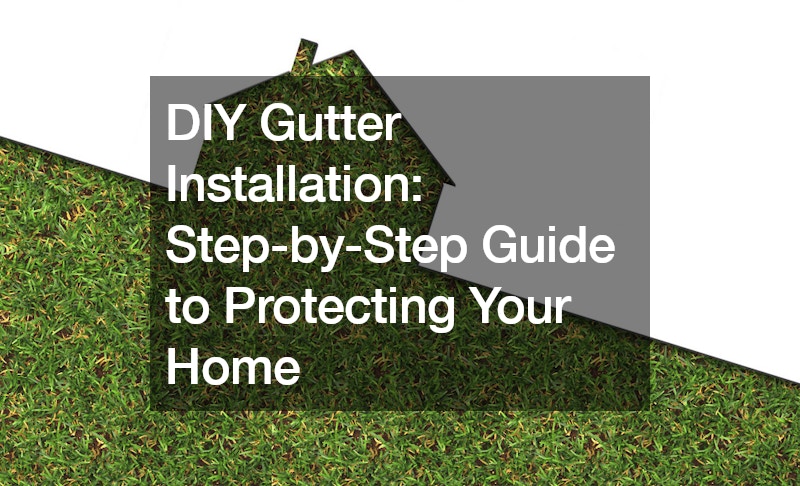
Gutters may not be the most glamorous feature of your house, but they play a crucial role in protecting it from water damage. Without them, rainwater can wreak havoc on your home’s exterior, causing everything from foundation issues to basement flooding. The good news is that installing gutters yourself is a manageable DIY project that can save you money and safeguard your home from potential damage. In this step-by-step guide, we’ll walk you through the process of DIY gutter installation, using simple language that anyone can understand.
1. Assess Your Home’s Needs
Before you begin installing gutters, take some time to assess your home’s needs. Look for areas where water tends to collect or where there is evidence of water damage, such as peeling paint or water stains.
These are the areas where gutters will be most beneficial in directing rainwater away from your home.
2. Gather Your Supplies
To install gutters, you’ll need a few basic supplies, including gutters, downspouts, end caps, brackets, screws, a drill, a level, and a hacksaw. You can find these supplies at your local home improvement store, and many stores offer gutter systems in pre-cut lengths for easy installation.
3. Measure and Mark
Using a tape measure, carefully measure the length of the areas where you plan to install gutters. Mark these measurements on the fascia board of your home using a pencil or chalk line. It’s essential to ensure that your gutters have the proper pitch for water drainage, so use a level to create a slight downward slope towards the downspouts.
4. Cut and Install End Caps
Using a hacksaw, cut your gutters to the appropriate length according to your measurements. Once cut, attach end caps to each end of the gutter using sealant and screws. This will create a watertight seal and prevent water from leaking out of the ends of the gutter.
5. Attach Brackets
Next, attach gutter brackets to the fascia board at regular intervals along the length of the gutter. These brackets will support the weight of the gutter and ensure that it remains securely attached to your home. Use a drill to screw the brackets into place, making sure they are level and evenly spaced.
6. Hang the Gutter
With the brackets in place, it’s time to hang the gutter. Start at one end and work your way towards the downspout, attaching the gutter to the brackets as you go. Use screws to secure the gutter to the brackets, making sure it is level and has the proper pitch for water drainage.
7. Install Downspouts
Once the gutter is securely attached, it’s time to install the downspouts. Measure and cut the downspouts to the appropriate length, then attach them to the gutter using screws and brackets. Make sure the downspouts are positioned to direct water away from your home’s foundation.
8. Test Your Gutters
With the gutters and downspouts in place, it’s time to test them to ensure they are functioning correctly. Use a hose to simulate rainfall and check for any leaks or overflow. Make any necessary adjustments to ensure that water is flowing freely away from your home.
9. Maintain Your Gutters
Once your gutters are installed, it’s essential to maintain them regularly to ensure they continue to protect your home from water damage. Clean out debris, such as leaves and twigs, regularly to prevent clogs and blockages. Check for any signs of damage, such as rust or loose screws, and make repairs as needed.
10. Enjoy Your Protected Home
With your DIY gutter installation complete, you can rest easy knowing that your home is protected from water damage. Gutters play a vital role in directing rainwater away from your home’s foundation, siding, and skylights, preventing costly repairs down the line. By following this step-by-step guide, you can install gutters yourself and safeguard your home for years to come.
Choosing the Right Gutter Material
When it comes to selecting the right gutter material for your home, there are several options to consider, each with its own set of advantages and disadvantages. Understanding the differences between materials like aluminum, vinyl, and steel can help homeowners make informed decisions tailored to their specific needs.
Aluminum gutters are one of the most popular choices due to their affordability, durability, and low maintenance requirements. They are resistant to rust and corrosion, making them ideal for areas with frequent exposure to moisture.
Vinyl gutters offer another cost-effective option for homeowners seeking low-maintenance solutions. They are lightweight, easy to install, and resistant to rust and corrosion. Vinyl gutters are also available in a variety of colors, making them versatile in terms of aesthetics.
Steel gutters are renowned for their strength and longevity, making them an excellent choice for homeowners prioritizing durability. They can withstand heavy loads, making them suitable for areas prone to snow accumulation.
In conclusion, each gutter material has its own set of benefits and drawbacks, and the right choice depends on factors such as budget, climate, and aesthetic preferences. Aluminum gutters offer affordability and versatility, while vinyl gutters provide low maintenance and easy installation. Steel gutters are prized for their strength and durability but require regular maintenance to prevent rust. By considering these factors and weighing the pros and cons of each material, homeowners can select the gutter system that best suits their needs and protects their home for years to come.
.





